Prodoodle: What Is It All About?
Because a team that draws together is drawn together…
Prodoodle(ling) has helped ProdPad build on its collaborative, creative and inspiring culture. Sure, it’s easy to throw those kind of terms around, but it’s even easier to get caught up in the busy-ness of business and not do anything practical to achieve them. But at ProdPad, we make the time!
What is Prodoodle?
Prodoodle is a creative workshop held twice a month. The whole company comes together and embraces the silliness, brilliance, failure and success that creativity entails. During this time, we’re also creating connections that grow beyond that space.
The design games we play are focused on our work, providing inspiration to people in all departments – not just those in creative-led roles. For example, the marketing team has found the games really valuable when looking at company branding and messaging. There’s also a friendly competitive spirit (it turns out ProdPadders love winning).

Where did the idea come from?
I joined ProdPad’s design team last August. When discussing my past creative endeavours I mentioned a drawing night that I used to run called Drinkydoodle. I set up Drinkydoodle with a fellow student (Billy Mather), while studying for an MA in Illustration at Brighton University. Our goal was to encourage drawing as a fun and accessible activity.
Drinkydoodle turned out to be pretty popular; mostly hosted in Sticky Mike’s Bar in Brighton, we also got invited to put it on in museums, art galleries and even a frogurt factory. The event itself consisted of a series of short drawing games, with the results of each game being immediately displayed in a makeshift gallery.
It turns out ProdPad’s Product Designer, Kav, had been wanting to do a creative workshop of some kind for a while but hadn’t had the scope (being the start and end of the design team tends to keep you busy). And thus, thanks to his enthusiasm and backing, Prodoodle was born!
How to do your own Prodoodle
Now, enough waffling from me, I’m sure you’re keen to get your own team Prodoodling. Here are just some of the games that we’ve found have worked well at ProdPad so far. Do get in touch if you have any questions – we’re always here to help.
1) The Product Box
Your app may be a digital SaaS product, but what if it was sold in a box, on a store shelf, like in days of yore?
- How would you grab people’s attention?
- What would you highlight as a reason to buy?
- What requirements are there for use?
(Note: If you don’t make a digital product, this could still work as a creative exercise. Presumably you already have some kind of packaging for your physical product, but let your non-designers have a go at re-imagining it)
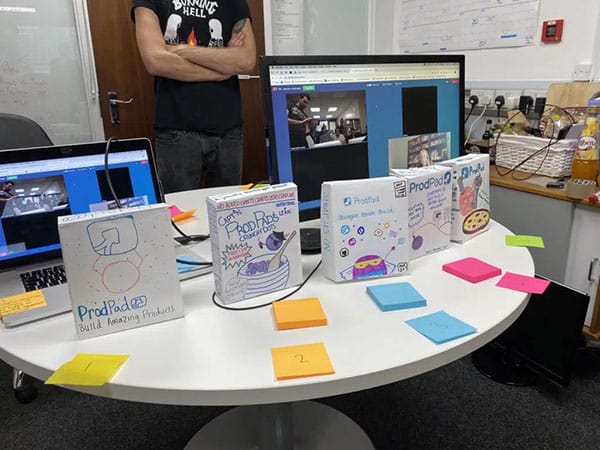
We found this game via – https://gamestorming.com/design-the-box/ adapting it a little for our own purposes.
How does it work?
- Break the players into teams of three or four people
- Each team spends 15 minutes coming up with lots of ideas and sketching them out
- Each team then presents their initial ideas to the group
- Teams then have 20 minutes to produce their box by drawing, writing, painting, sticking etc… on the box templates provided
- Be sure to leave a few minutes to assemble the box at the end
- Each team then presents their box to the group
- A winner is chosen and a prize awarded

Materials
- Pens
- Paper
- Card box templates
What’s the benefit?
This exercise helps your team to think laterally about your product by changing the context, to come up with some interesting ideas (that the marketing team might be able to use), and produce a fun and colourful outcome.
2) World’s Worst
In this game we’re going to flip things on their head. Instead of trying to be the best, we’re going to try to be the very worst.
How does it work?
In teams of three(ish), the aim is to create a presentation for the worst possible (whatever you want) product.
The final presentation may be a series of wireframe sketches from the app, an elevator pitch, some marketing materials, or anything else that will explain the awfulness of the really terrible app.
- Teams have 15 minutes to come up with their initial ideas
- Each team will then quickly present these ideas
- Teams will then have another 20 minutes iterating on their ideas and putting together the final presentation
- They will then present their app to the group
- The winning team is awarded a prize

Materials
- Pens
- Paper

We found this game via – http://www.uxforthemasses.com/worlds-worst/ but again adapted it a little for our own purposes.

What’s the benefit?
It’s easier to know what to avoid once the worst is understood. This helps to align everyone on what you do, want to do, and should help everyone to understand the vision and direction of the product more clearly.
3) Product Stones
Secret Stones is a game children play whereby they paint a stone and include their name or a message and then hide it somewhere for others to find. Upon finding a stone, the finder stealthily takes a photo of themselves with the stone, posts it to social media (usually a local Secret Stones Facebook page) and then carefully puts it back where it was for the next person to find.
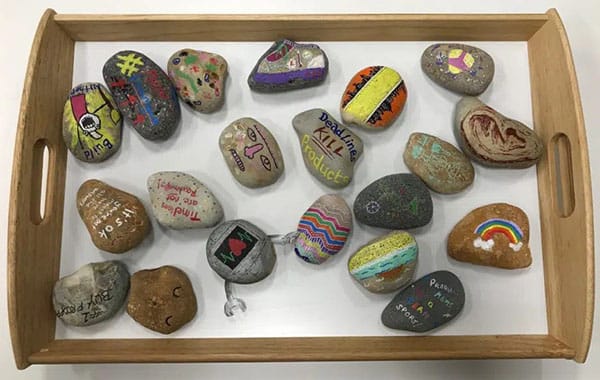
How does it work?
Each player will think of a Product Management tip/pitfall which they will then write on one side of the stone, and then paint a visual representation of it on the other.
- Each person has 30 minutes to ‘paint’ their stone
- They each then share the tip/pitfall and the painted stone with the group
- A prize will be awarded for the best overall tip/stone
- But… it’s not over yet
- They then hand in the stones to be hidden
- Each player then needs to try and find as many stones as possible, stealthily take a photo with it, and post the stone and tip to Twitter with #ProductStones (or something similar). The person who finds and shares the most stones & tips will also win a prize
Note: We did this with product management tips as that’s our thing, but the content can be adapted to your industry.
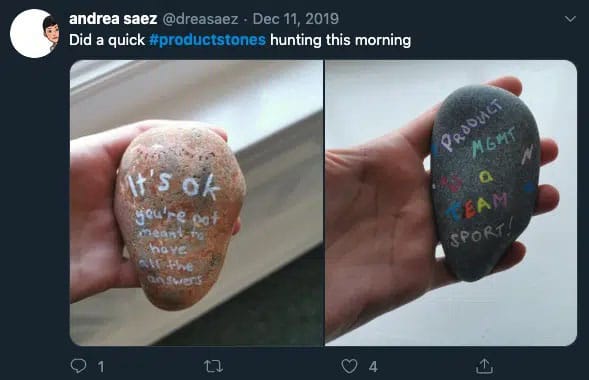
Materials
- Enough pebbles or stones for at least one for each per person
- Paint & brushes, or we found paint pens worked well as they made less mess
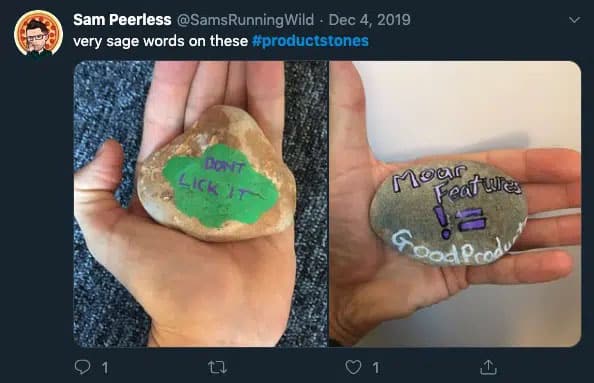
What’s the benefit?
Writing and drawing the stones gets people thinking about how to highlight some quick and pithy tips or pitfalls, sharing the stones on social media helps with getting new content out on those channels, which helps with marketing and brand awareness. It’s also pretty fun for everyone searching around for the stones.
4) Doodling Prodoodle
A series of short drawing games with an aim to promote drawing as a tool for thinking and communicating. The target audience is definitely people who can’t draw as much as people who can.

How does it work?
Alphadoodle
Prepare one sheet for every person who will be playing. Write a letter of the alphabet on each piece, then distribute the sheets amongst everyone.
The players have three minutes to draw as many things as possible that start with the letter on their sheet.
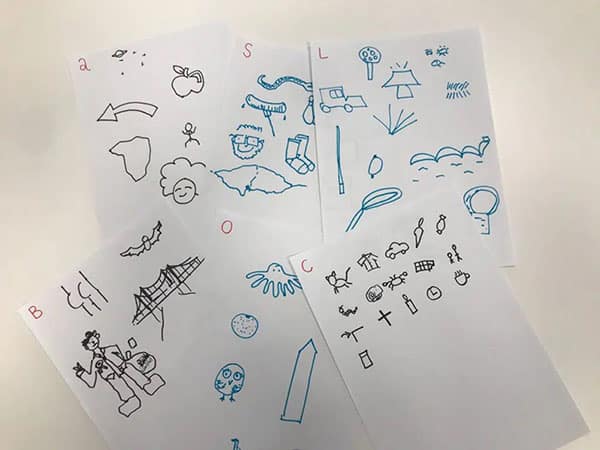
Finish the drawing
Prepare one sheet of paper per person who will be playing. Draw a squiggly line or two on each piece, then distribute the sheets amongst everyone.
The players have three minutes to create a picture using your lines as a starting point. You can pick a theme for the images too to get people going.

Quick draw
Each player has 60 seconds to draw a self portrait
Frankendoodle
Based on the surrealist game Exquisite Corpse, this works best using A3 sheets of paper. Fold the paper into four equal strips and mark one for the head, one for the body, one for the legs and one for the feet. The sheets can then be passed around amongst the players until their creations are complete.

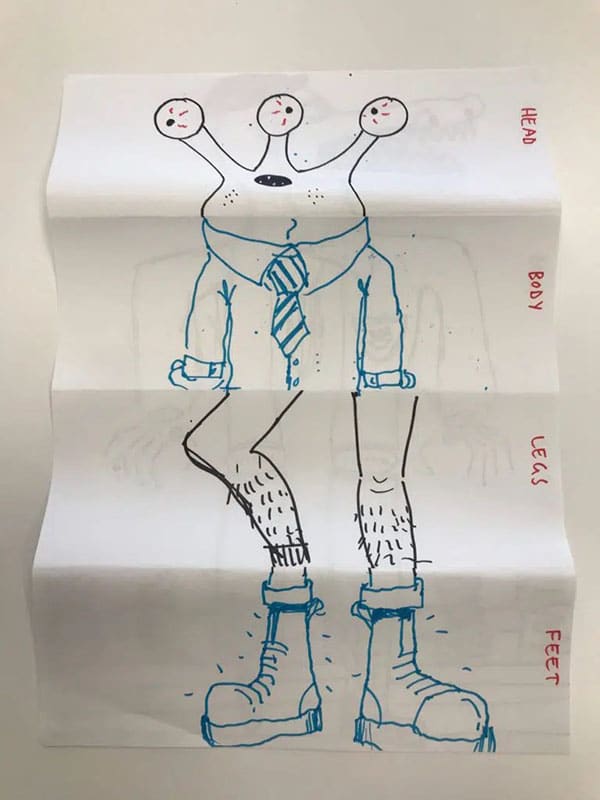
Lucky draw
Players pick out a verb from one hat and a noun from another hat (these need to be written on little bits of paper in advance), they then have three minutes to draw the combined thing – whatever that is.
Drawn together
Each player writes their name on a little piece of paper and puts it into the hat. The players then take it in turns picking a name. They then have to draw that person. This game is great for breaking the ice if people don’t know each other too well.
Shout out
Players take it in turns shouting out random things for everyone to draw. Each drawing should be done in 30 seconds to keep movement going. This can be carried on for as long as wanted.
Materials
- Lots of paper
- Pens
- String and clothes-pegs to hang up the pictures at the end of each round
What’s the benefit?
Drawing is a really useful tool for explaining ideas. These games serve to increase the players confidence in their drawing abilities and their ability to communicate with their drawings. As with all of the other Prodoodle games described they also help with team building and creative thinking. At ProdPad we find it really beneficial and worthwhile.
Let us know how you get on with your own versions of prodoodle. Tweet us at @prodpad and share your stories.